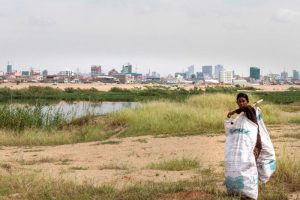Perhaps it’s because I’ve visited Cambodia a few times and have enjoyed some memorable conversations with some wonderful ordinary people-in-the-streets/villages there. Also no doubt because I’ve visited their horror sites, the places where the Khmer Rouge butchered countless people. Or is it because I’ve seen the many orphanages, the many maimed with stories to tell of the Khmer Rouge, the Vietnamese, the US bombing. Or is it because of the so many young people proportionate to old — you know why if you have the slightest knowledge of their history. The poverty, matched only by the friendliness, and the anxiety about criminals furtively working behind the scenes to take advantage of the vulnerable, especially children. Or is it the day I saw that group of “ugly American” tourists loudly demanding discounts at heritage sites because these fat, wealthy white intruders whose government bombed much of their land to a moonscape felt that as “seniors” they were entitled to entry-fee discounts! (I doubt most Cambodians can ever expect to live as long as most Americans anyway, but that’s beside the point.) But for whatever reasons, news stories like this provoke feelings of disgust in my stomach. . . .
US attempt to recoup Cambodian debt ‘cack-handed’: former Australian Ambassador
At the time, Hun Sen said the money his country owed the US was incurred by the Lon Nol government that came to power in a 1970 coup backed by Washington, and that it was spent on arms used against the Cambodian people.
The official US line was that the loan had been for agricultural development and that Cambodia had the means to repay.
Hun Sen raised the issue again this year, with Cambodian media reporting the PM as saying the US had no right to demand repayment of a debt that was “blood-stained” from the brutal US bombing of Cambodian territory during the Vietnam War.
Former Australian ambassador to Cambodia Tony Kevin said American activity in the early 1970s had done great harm to Cambodia, and it was well understood in foreign policy circles that it had contributed to rise of the Khmer Rouge.
Lon Nol was toppled in 1975 by the ultra-Maoist Khmer Rouge regime, under which an estimated 1.7 million people died in less than four years, plunging Cambodia into decades of poverty and political instability.
“At the same time the US was giving weapons to Lon Nol, it was bombing the Cambodian countryside into oblivion and creating millions of refugees fleeing into Phnom Penh and destroying all political fabric and civil life in the country,” Mr Kevin said.
“And all of this was simply to stop the supplies coming down to South Vietnam, as it was then, from the north.
“So the United States created a desert in Cambodia in those years, and Americans know this.”
. . . . . .”We all would have thought it inconceivable that the United States would be approaching Cambodia now in 2017, 50 years later, with such a bill,” he said.
A photo from that same news story that brought back powerful memories of my own:
My own recollection was of walking down a street that on one side for many hundreds of meters, perhaps even a few kilometres, were palatial mansions, high rises, exotic architecture, expensive cars in driveway; on the other side, dirt, faded grass planted with sticks and tin, torn canvasses and plastic for “homes” (shelters for sleeping at night), all the way along that same stretch of road: millionaires literally facing the beggars and destitute.
Of course the government protects corruption throughout society. That’s equally obvious to the casual visitor who cares to think for ten seconds about what he or she sees all around. (That’s most people, I’m sure, except for those “ugly Americans” and their ilk.)
And now Trump, and the demands for a paltry sum in the grand scheme of things.
What the hell is a white, western power doing over in this part of the planet in the first place, anyway?

